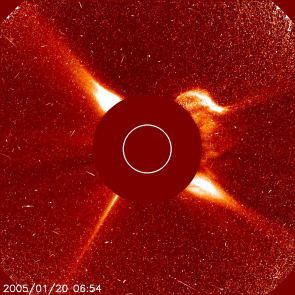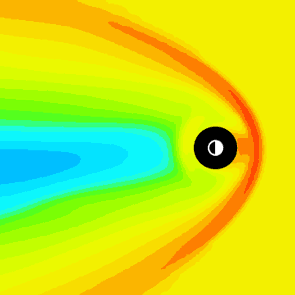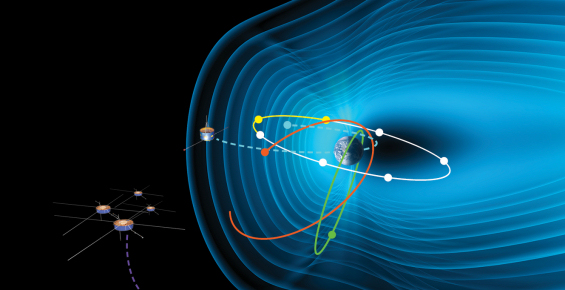A mixed-up magnetic storm
28 August 2014
The Sun is a variable star, experiencing 11-year-long cycles of activity which impact our planet and near-Earth space. Forecasting the changing space weather and the effects it will have on Earth remains a challenge, as illustrated by an unusual magnetic storm that was observed by ESA's Cluster quartet and one of the Chinese-ESA Double Star spacecraft.
 |
| Coronal mass ejection, 20 January 2005. Credit: SOHO (ESA & NASA) |
On 20 January 2005, the ESA/NASA SOHO spacecraft detected an explosion on the Sun which ejected a huge cloud of plasma (electrically charged gas) into space. Subsequent observations indicated that this was one of the fastest coronal mass ejections (CMEs) during solar cycle 23, with a velocity that peaked at perhaps 3000 km/s at a distance of between 3 and 50 solar radii, before slowing to 1000 km/s as it approached Earth. The typical speed of particles in the solar wind is 400-700 km/s.
As a result, the CME took only 34 hours to cross the 150 million km gulf between the Sun and Earth, compared with the typical time of 3-4 days.
The fast-moving cloud acted like a snow plough, driving into slower-moving solar wind material ahead of it and compressing the plasma so that it piled up in a high density - high temperature sheath region, preceded by an interplanetary shock.
By the time it reached Earth's vicinity, the CME exhibited two extremely unusual features. First, it was observed to contain a large amount of solar filament material. Filaments are ribbons of dense plasma that are driven upward into the Sun's outer atmosphere – the corona – by strong magnetic fields emerging from active regions. However, despite observations indicating that more than 70% of active region eruptions involve solar filaments, these structures are rarely identifiable in CMEs arriving at Earth.
Second, the filament material was displaced from its expected position in the CME. As the coronal mass ejection decelerated en route to Earth, the momentum of the massive solar filament caused it to push its way toward the front, eventually making contact with the sheath region.
What happened next was observed by a flotilla of Earth-orbiting scientific satellites, including ESA's Cluster quartet, the Chinese-ESA Double Star TC-1 spacecraft, and various US spacecraft, as well as the ground-based SuperDARN radar network. They provided a unique opportunity to study the impact and merger of the CME material with the magnetosphere – the invisible magnetic bubble which surrounds our planet.
At the time of the CME's impact with Earth's magnetosphere on 21 January 2005, Cluster was in the solar wind directly upstream of Earth, acting as a solar wind monitor.
Meanwhile, Double Star TC-1 was passing from the outer region of the planet's magnetic field (the magnetosheath) and entering the magnetosphere. This enabled it to observe the entry of the solar filament material as it crossed into the magnetosphere.
The magnetic storm that resulted from the CME impact on 21 January was moderate in intensity, since the interplanetary magnetic field was mainly northward – the same as Earth's magnetic field. (A geomagnetic storm occurs when mass, energy and momentum from the solar wind penetrate into the magnetosphere and disrupt the particles and the fields in near-Earth space. Major storms can cause damage to satellites in orbit around the Earth, and induce currents in the ground that damage or disrupt power grids.) However, the dense solar filament embedded in the incoming cloud produced a number of effects which made it behave in some ways like a superstorm.
 |
| Effect on Earth's magnetosphere of the CME of 20 January 2005. Credit: Visualisation by Lutz Rastaetter, Community Coordinated Modeling Center/NASA Goddard Space Flight Center |
"The data show that the dense filament material following immediately behind the sheath in the CME was directly or indirectly responsible for most of the unusual features in the geomagnetic storm which resulted," says Janet Kozyra, a researcher at the University of Michigan, Ann Arbor, USA, and lead author of a recent paper on the effects of the CME, published in the Journal of Geophysical Research, Space Physics.
"The arrival of the filament, in combination with a thin layer of southward interplanetary magnetic fields at its leading edge, resulted in a superfountain in the equatorial ionosphere. Around 18:50 UT on 21 January, near the planet's day-night boundary, Earth's ionospheric layer shot upward at a speed of more than 1000 m/s, rising above 900 km within ten minutes. The typical altitude of this layer is 300 km. Satellites in the region, now under the layer, saw a drop in ionospheric densities by a factor of 100. The development of a superfountain is highly unusual during such a moderate magnetic storm."
Within one hour of the impact, a cold, dense plasma sheet had formed out of the filament material and high density material continued to move through the magnetosphere for the entire six hours of the filament's passage. Simulated and observed plasma sheet densities exceeded tens of particles per cubic centimetre along the flanks – high enough to inflate the magnetotail under northward magnetic field conditions, despite the cool temperatures. These high densities were driven inward as the massive solar filament compressed the magnetosphere.
Other unusual effects were the equatorward spread of the auroral oval and strong heating in the polar ionosphere.
"Case studies such as this – which combine all available satellite observations in regions from Sun to Earth with linked global models – allow us to trace chains of processes and their interactions, in order to identify the drivers of the extreme features and track the changes that appear throughout the system as a consequence," remarks Kozyra.
"Predicting the impact of the Sun's activity on Earth is one of the major goals of space weather research," says Philippe Escoubet, ESA's project scientist for Cluster. "However, we are not there yet. It is well known that similar solar observations and solar wind conditions can lead to totally different consequences on the Earth's magnetic environment.
"Coordinated observations and modelling of unusual events by multiple spacecraft orbiting near Earth are essential if we are to improve our understanding of the Sun-Earth connection."
Background Information
Solar filament impact on 21 January 2005: Geospace consequences, by J.U. Kozyra and colleagues is published in the Journal of Geophysical Research: Space Physics, Volume 119, Issue 7, pages 5401-5448, July 2014; DOI: 10.1002/2013JA019748.
The study is based on measurements from twelve spacecraft operating in the Earth's magnetosphere: ESA's four Cluster spacecraft, one of the Chinese-ESA Double Star spacecraft (TC-1), the Advanced Composition Explorer (ACE), the Imager for Magnetopause-to-Aurora Global Exploration (IMAGE) satellite, and five geosynchronous satellites from Los Alamos National Laboratory. An additional nine low-altitude satellites provided measurements of the effects in the ionosphere and atmosphere.
Cluster is a constellation of four spacecraft flying in formation around Earth. It is the first space mission able to study, in three dimensions, the natural physical processes occurring within and in the near vicinity of the Earth's magnetosphere. Launched in 2000, it is composed of four identical spacecraft orbiting the Earth in a pyramidal configuration, along a nominal polar orbit of 4 × 19.6 Earth radii (1 Earth radius = 6380 km). Cluster's payload consists of state-of-the-art plasma instrumentation to measure electric and magnetic fields over wide frequency ranges, and key physical parameters characterising electrons and ions from energies of near 0 eV to a few MeV. The science operations are coordinated by the Joint Science Operations Centre (JSOC) at the Rutherford Appleton Laboratory, United Kingdom, and implemented by ESA's European Space Operations Centre (ESOC), in Darmstadt, Germany.
Contacts
Janet U. Kozyra
University of Michigan
Ann Arbor, Michigan, USA
E-mail: jukozyra![]() umich.edu
umich.edu
Philippe Escoubet
Cluster Project Scientist
Scientific Support Office
Directorate of Science & Robotic Exploration
ESA, The Netherlands
Phone: +31-71-565-3454
E-mail: Philippe.Escoubet![]() esa.int
esa.int





